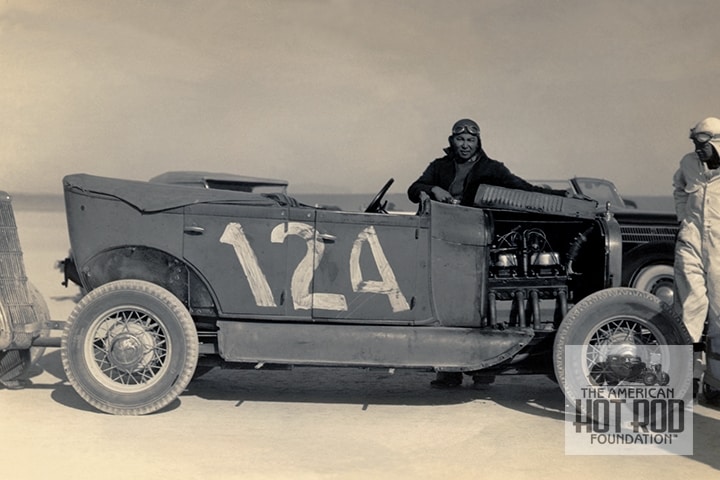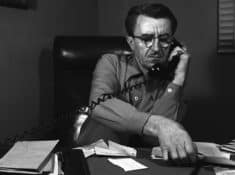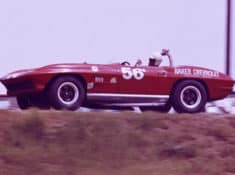Before the attack on Pearl Harbor and the advent of World War II, the Japanese, both those born in Japan (Issei) and those born in the U.S. (Nisei) were just another ingredient in the American immigrant melting pot. However, that all changed on December 7, 1941, and on February 19, 1942, President Roosevelt signed Executive Order 9066 beginning Japanese American internment. Over the course of the war, approximately 110,000 Japanese Americans and Japanese who lived on the West Coast of the United States were uprooted from their homes and interned. It was a dark period in U.S. history.
Born in Monrovia, California, in 1915, where his father had a fruit market, Frank Morimoto was the fifth of eight children and one Nisei who would be forever affected by EO9066. Before the war, Frank was a regular at Muroc and according to his brother George writing in the Japanese magazine Cruisin, “Frank first ran his ’28 Ford in 1935.” Photos indicate a Phaeton sans fenders and with a Winfield head, it ran 89.11 mph. The next thing he did, according to George, was swap the Phaeton for a Roadster and change out the two-port head for a Riley four-port purchased from George Riley. With the new set up he achieved a personal best of 122.97 in 1937. The ’29 had a wicked pair of shotgun pipes that ended halfway down the passenger door—with no mufflers.
George then goes on to tell us that Frank purchased a Roots-type supercharger from Mercedes Benz in Germany. Dean Batchelor, in his book The American Hot Rod confirms that Frank had a Roadster with a Mercedes-Benz blower. Unfortunately for Frank, the blower was not a huge success and according to George was sold to Bill Spalding who lived close by and was likewise a member of the Mobilers club with Frank.
Interestingly, Frank gets a call out in the February 1941 issue of Throttle magazine: “A recent drag race between Frank Morimoto of Pasadena and Bud Hines, ended in a major victory for Morimoto, we understand. Frank had a neat little chug with a Molar four-port head and a roots blower. Bud pushes around a Cragar roadster that’s been clocked at 113 m.p.h. It took place one Sunday morning on Peck Road near Santa Anita racetrack.” The news item goes on to say: “That’s one thing we don’t advocate… highway racing… because it’s d—— foolish, dangerous, and gets ‘nobody nowhere.’”
What’s interesting is the 1941 use of the term drag racing. Frank’s name appears once more in Throttle in the April ’41 issue with a picture of his Roadster. The caption says, “Mohler four-port, owned by the Morimoto Brothers of the Mobilers and equipped with a Roots blower.” Besides his brother George and fellow club members, Frank was accompanied by his girlfriend Yuri who also drove and recorded a best personal speed of 106 mph. They were married in October 1941.
Dates here get a little confusing but according to records, Frank had already volunteered and joined the army on January 31, 1941—he intended to serve a year but did five. He ended up in Company F, 2nd Battalion, 442nd Infantry Combat Team—famous for their slogan, ‘Go For Broke’. This all-volunteer, Japanese-American combat team was memorialized in the 1951 movie ‘Go For Broke’ that was nominated for an Academy Award. The 442 were the most highly decorated unit for their size and length of service in the history of the U.S. Army, with one of the highest casualty rates. And they did it all while their families were unjustly interned in detention camps back in the USA.
As a rifleman, Frank was stationed in Italy and France and fought in the Battle of Bruyeres; participated in the famed Rescue of the Lost Battalion; and saw action in the Champagne Campaign in the Maritime Alps. He was awarded the Bronze Star, Good Conduct Medal, World War II Victory Medal, Distinguished Unit Badge and more. And all that time he fought for his county his family was interned at Heart Mountain, Wyoming, where his mother died.
Some accounts of Frank’s life, including that of his brother George, say that upon his return from the war, the house in Monrovia had been looted as was the case for many of the Japanese and Japanese Americans interned. Nevertheless, we did find a picture in Dean Batchelor’s book—the caption says, “The Morimoto brothers’ Cragar-equipped Model B engine in a ’29 Roadster ran a Roots blower from a Mercedes Benz. The camshaft was stock, but the ignition was a Bosch unit. On September 21, 1947, the car clocked 115.83, and on October 19, it managed 116.73 mph.”
Subsequent to that, we don’t hear of Frank as a racer instead, he became an aeronautical engineer, building jet engines and delta rockets for the Aerojet Engineering Company. Frank died on May 8, 2008, leaving Yuri his loving wife of 64 years, his four devoted daughters and their husbands, eight grandchildren and nine great-grandchildren. He also left a hot rod legacy that not many know about. He was probably the first hot rodder to run a Roots-type blower at the lakes and he fought for his country and lived through that terrible ordeal.
By Tony Thacker

Frank Morimoto and his 4-Port Riley headed Phaeton was snapped by Allen Hawkins at the May 15th S.C.T.A. meet at Muroc back in 1938. Frank blasted through the traps at an eye-opening speed of 107 mph. At the July 3rd trials at Muroc wearing the number 129, he was even quicker with a speed of 108.43 mph. At the October meet held at Harper Frank slowed to 105 mph now wearing the number 98.
©AHRF/Frank Morimoto Collection
 Berardini Brothers
Berardini Brothers Chuck Daigh
Chuck Daigh Eddie Edmunds
Eddie Edmunds Dick Guldstrand
Dick Guldstrand

